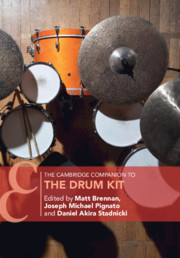Book contents
- The Cambridge Companion to the Drum Kit
- Cambridge Companions to Music
- The Cambridge Companion to the Drum Kit
- Copyright page
- Contents
- Figures
- Tables
- Music Examples
- Notes on Contributors
- Introduction
- Part I Histories of the Drum Kit
- Part II Analysing the Drum Kit in Performance
- Part III Learning, Teaching, and Leading on the Drum Kit
- Part IV Drumming Bodies, Meaning, and Identity
- 14 The Meaning of the Drumming Body
- 15 Disability, Drumming, and the Drum Kit
- 16 Seen but Not Heard
- 17 Building Inclusive Drum Communities
- 18 A Window into My Soul
- Index
14 - The Meaning of the Drumming Body
from Part IV - Drumming Bodies, Meaning, and Identity
Published online by Cambridge University Press: 28 May 2021
- The Cambridge Companion to the Drum Kit
- Cambridge Companions to Music
- The Cambridge Companion to the Drum Kit
- Copyright page
- Contents
- Figures
- Tables
- Music Examples
- Notes on Contributors
- Introduction
- Part I Histories of the Drum Kit
- Part II Analysing the Drum Kit in Performance
- Part III Learning, Teaching, and Leading on the Drum Kit
- Part IV Drumming Bodies, Meaning, and Identity
- 14 The Meaning of the Drumming Body
- 15 Disability, Drumming, and the Drum Kit
- 16 Seen but Not Heard
- 17 Building Inclusive Drum Communities
- 18 A Window into My Soul
- Index
Summary
Drumming is often pigeonholed as solely a visceral experience. Although it is almost impossible to hide this visceral nature, it undoubtedly has cognitive components, which supports the idea of music as an embodied activity. In this essay, I analyse John Bonham’s performance on Led Zeppelin’s ‘When the Levee Breaks’ (1971) to demonstrate how cognitive scientist Mark Johnson’s five dimensions of the human body (biological, ecological, phenomenological, social, and cultural) can reveal meaning in drumming. By applying all five levels to the song one at a time, I peel back layers of meaning. In Johnson’s final level, I propose what I term a Tonic Beat Pattern Theory based on tension and release that serves as a method of drum analysis across rock music to explain how drummers contribute to affect and meaning. In any band, the drummer is the main driver of rhythm and groove. Drummers create musical trajectories in songs that not only make fans wiggle our hips, move our feet, and bang our heads, but also, create just about any affect the song calls for. This essay begins to uncover why rock drumming matters.
Keywords
- Type
- Chapter
- Information
- The Cambridge Companion to the Drum Kit , pp. 197 - 209Publisher: Cambridge University PressPrint publication year: 2021
- 2
- Cited by

